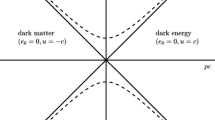Abstract
The existence of so-called dark energy and matter in the universe implies that the conventional accounting of mass and energy is incorrect. Here, we use the framework of special relativity and validation through Lorentz invariance to develop an alternative accounting of mass and energy. We assume the usual Einstein relations of special relativity, but we make the distinction between the particle energy \(e = mc^2\) and the actual work done by the particle \( \mathscr {E}\), and we adopt the perspective that it is not just the momentum vector \({\mathbf{p} = m\mathbf{u}}\) that contributes to the work done \( \mathscr {E}\), but rather the intrinsic particle energy e itself plays an important role through the combined potentials \((\mathbf{p}, e/c)\) as a well-defined four vector within special relativity. The resulting formulation provides a natural extension of Newton’s second law, emerges as a fully consistent development of special relativity that is properly invariant under the Lorentz group, and yields an extension of Einstein’s famous equation for the work done involving new terms. The new work done expressions can involve the \(\log \) function and possibly generate extremely large energies that might well represent the first formal indication of the origin of dark energy. Two alternative expressions are both well defined as a limiting case for energy–mass waves travelling at the speed of light and are in complete accord with well-established theory for photons and light for which energy is known to vary linearly with momentum. The present formulation suggests that large energies might be generated even for slowly moving systems, and that dark energy might arise in consequence of conventional mechanical theory neglecting the work done in the direction of time.
Similar content being viewed by others
References
Feynman, R.P., Leighton, R.B., Sands, M.: The Feynman Lectures on Physics, vol. 1. Addison-Wesley, Boston (1964)
Landau, L.D., Lifshitz, E.M.: Course of Theoretical Physics, vol. 2. Addison-Wesley, Boston (1951)
Lee, A.R., Kalotas, T.M.: Lorentz transformations from the first postulate. Am. J. Phys. 43, 434–437 (1975). https://doi.org/10.1119/1.9807
Lévy-Leblond, J.-M.: One more derivation of the Lorentz transformation. Am. J. Phys. 44, 271–277 (1976). https://doi.org/10.1119/1.10490
Saari, D.G.: Mathematics and the “dark matter” puzzle. Am. Math. Mon. 122, 407–427 (2015). https://doi.org/10.4169/amer.math.monthly.122.5.407
Weinstein, G.: Variation of mass with velocity: “kugeltheorie” or “relativtheorie” (2012). ar**v:1205.5951 [physics.hist-ph]
Author information
Authors and Affiliations
Corresponding author
Rights and permissions
About this article
Cite this article
Hill, J.M. On the formal origins of dark energy. Z. Angew. Math. Phys. 69, 133 (2018). https://doi.org/10.1007/s00033-018-1028-4
Received:
Revised:
Published:
DOI: https://doi.org/10.1007/s00033-018-1028-4




